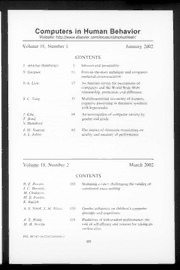
Computers in Human Behavior 2002: Vol 18 Table of Contents PDF
Preview Computers in Human Behavior 2002: Vol 18 Table of Contents
Computers in Human Behavior Website: http://www.elsevier.com/locate/comphumbeh/ Volume 18, Number | January 2002 CONTENTS Y. Amichai-Hamburger Internet and personality N. Guéguen Foot-in-the-door technique and computer- mediated communication S.-S. Liaw An Internet survey for perceptions of computers and the World Wide Web: relationship, prediction, and difference Multidimensional taxonomy of learners cognitive processing in discourse synthesis with hypermedia J. King, An investigation of computer anxiety by T. Bond, gender and grade AS Blanc ford J. M. Stanton Che impact of electronic monitoring on 4. L. Julian quality and quantity of performance Volume 18, Number 2 March 2002 CONTENTS D. E. Powers Stumping e-rater: challenging the validity of J. C. Burstein, automated essay scoring M. Chodorow M. E. Fowles, K. Kukich A. §. North, J. M. Noves Gender influences on children’s computer attitudes and cognitions A. Y. Wang, Predictors of web-student performance: the M.H. Newlin role of self-efficacy and reasons for taking an on-line class PII: S0747-5632(02)00066-3 1. M. Haggas, 165 Think or click? Student preference for overt D. A. Hantula vs. covert responding in web-based instruction Computer-mediated communication in i & Baril F. T. Durso collaborative writing Mf. Hassnert Development context and ease of use of three C.M {//]M OO"U ] programs for self-registration of unemployed people Volume 18. Number : May 2002 CONTENTS 4942 Job characteristics and computer anxiety in 1. Vik ke Lse /) 1 Ovaard, the production industry Po Lindoe, . Einar Olsen Potosk\ \ field study of computer efficacy beliefs as an OLOSK \ outcome of training: the role of computer playfulness, computer knowledge, and performance during training Savicl VU Effects of training on computer-mediated communication in single or mixed gender {007 small task groups Personality traits and computer anxiety as predictors of Y2K anxiety Applicant preferences for Web-based versus traditional job postings Eliciting children’s recall of events: how do VM B Powell .% Wilson computers compare with humans? D. M. Thomson J.-P. Gaudron, E Vignoli Assessing computer anxiety with the interaction model of anxiety: development and validation of the computer anxiety trait subscale J. Veenman Initial inductive learning in a complex Prins, J. J. Elshout computer simulated environment: the role of metacognitive skills and intellectual ability IV Volume 18, Number 4 July 2002 CONTENTS T. Whitty 34: Liar, liar! An examination of how open, supportive and honest people are in chat rooms . M. Vermand & SY RLIST: a representation scheme for the .C. M. Weusten, automated comparison of psychopathological 1. J. M. Coppen, scales and syndromes . Kracht . B. Woszczynski, Exploring the theoretical foundations of _L. Roth, A. H. Segars playfulness in computer interactions . Fox, D. Schwartz Social desirability and controllability in computerized and paper-and-pencil personality questionnaires Sc. bin-€-€. Tsai Sensation seeking and internet dependence of Taiwanese high school adolescents . Jansen-Osmann p Using desktop virtual environments to investigate the role of landmarks J. Swickert Relationships among Internet use, . Hittnei personality, and social support .. Harris, . Herring ’. Bressani 5 Youth independent living assessment: testing Downs the equivalence of web and paper, pencil versions of the Ansell—Casey Life Skills Assessment Principles for using animation in computer- based instruction: theoretical heuristics for effective design ‘olume 18, Number September 2002 CONTENTS Torkzadeh 479 Effects of training on Internet self-efficacy and T. P. Van Dyke computer user attitudes B. Williams 495 Aggression, competition and computer games: 1. Clippinger computer and human opponents Private e-mail requests and the diffusion of . Barron, E Yechiam responsibility . Durndell, Z. Haag Computer self efficacy, computer anxiety, attitudes towards the Internet and reported experience with the Internet, by gender, in an East European sample Reading news from a pocket computer in a distracting environment: effects of the tempo of background music E. Caplan Problematic Internet use and psychosocial well-being: development of a theory-based cognitive-behavioral measurement instrument M. B. Powell Evaluation of the usefulness of ‘Marvin’: a computerized assessment tool for investigative tf ( a ilson VM. K. Hasty interviewers of children An examination of the relationship between { I Ro é lhe R. S. Landis use of the Internet as a recruitment source and student attitudes Volume 18. Number 6 November 2002 CONTENTS SPECIAL ISSUE: COMPUTER-BASED ASSESSMENT OF PROBLEM SOLVING Editor’s introduction H. F. O'Neil. Jr 605 Perspectives on computer-based assessment of problem solving 609 Measuring problem solving in computer environments: current and future states \ taxonomy for computer-based assessment of problem solving Challenging minds? Students’ perceptions of VU. Ric hai dson J.-A. Baird, J. Ridgway, computer-based World Class Tests of problem M. Ripley solving D Shorrocks-Tavlor. \ 1. Swan . D. Tennyson, Improving problem solving and creativity . Breuer through use of complex-dynamic simulations 1, K. W. K. Chung, Cognitive process validation of an online . F. de Vries, problem solving assessment M. Cheak, . H. Stevens, . L. Bewley . Leutner The fuzzy relationship of intelligence and problem solving in computer simulations E=f£,. G. Hsieh, Types of feedback in a computer-based H. F. O'Neil, Jr. collaborative problem-solving group task J. D. Fletcher, Effectiveness and cost benefits of computer- R. Johnston based decision aids for equipment maintenance M. Fiore, Training individuals for distributed teams: M. Cuevas, S. Scielzo, problem solving assessment for distributed % Salas mission research ER ONG IRF: Assessing problem solving in expert systems E. L. Baker, using human benchmarking M.C. Wittrock .. Kim,B . E. Kolko, Web-based problem solving learning: third- T. H. Greer year medical students’ participation in end-of- life care Virtual Clinic Developing competency-based methods for . Bennett, Jr., near-real-time air combat problem solving T. Sc hreiber, H. {ndr« ws assessment ~. L. Orvis Communication patterns during synchronous R.A. Wisher, C. J. Bonk, Web-based military training in problem T. M. Olson solving Volume 18 Contents Author Index
